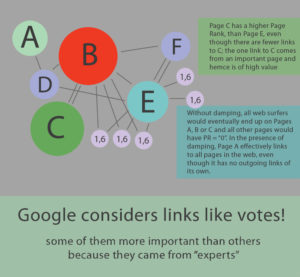PageRank
Lately I’ve faced with the problem, that some clients don’t exactly understand what is PageRank and how it works. Most of them think (according to the name), that it is the rank your page is given and placed on the SERP (Search Engine Result Page). This is partly right – PageRank is an algorithm used by Google Search to rank websites in their search engine results. It is counting the number and quality of links to a page to determine a rough estimate of how important your website is and how relevant your page could be for the exact keyword query. But let’s explore the subject to be sure we understand it inside out, because it’s the core subject of SEO. Let’s look back to early 90’s…

How the Google started?
PageRank was developed at Stanford University by Larry Page and Sergey Brin in 1996. First, as part of a research project about a new kind of search engine. Sergey Brin offered an idea to order information by hierarchy, by “link popularity”. The more links refer to the page – the heir its rank.
Guys were writing dissertations and as usual, at the end of the scientific report they placed a list of reference, where sources are located according to their importance for the study. The most relevant (refer) – at the top of the list. Genius lies in simplicity – this principle formed the basis of Page Rank classification.
The first paper about the project, describing PageRank and the initial prototype of the Google search engine, was published in 1998. Shortly after, Page and Brin founded Google Inc. But it is just one of many factors (and not very cogent) that determine the ranking of Google search results. The name “Page Rank” plays off of the name of developer Larry Page. Though the word – is a trademark of Google, the patent is belongs to Stanford University and not to Google.
Today, the attention is focused on the value of the resource, that links. Because of the black SEO method of buying links – Google decided that they should improve the situation. They started to take into consideration the thematic of the linking resource – it should be the same or close to the resource on which it links and time, users spend there. But it is a huge subject, for a new post….




0 Comments